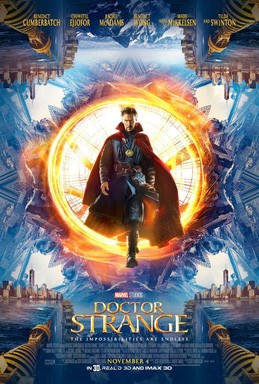Those eagerly awaiting Benedict Cumberbatch’s triumphant entrance into the Marvel Cinematic Universe need wait no further.
The British actor has now joined the ranks of Chris Evans, Robert Downey Jr. and company with his very own Marvel superhero film.
In “Doctor Strange,” Cumberbatch plays Stephen Strange, a brilliantly talented, yet narcissistically arrogant neurosurgeon.
One night, while driving down a dark, mountainous road, he swerves his car off the mountain, resulting in a horrific car accident and a horribly-injured Dr. Strange.
Eventually, his body begins to recover, except for his hands, which he can no longer use.
Unusable hands don’t get you very far in the field of neurosurgery, so when all forms of physical therapy fail him, Strange decides to pursue more unconventional methods of treatment.
This leads him to Nepal, and to the fortress of the Ancient One (Tilda Swinton), a legendary sorcerer who teaches students about the mystic arts and allows them to travel to other dimensions.
Strange begins to train there, and slowly becomes a powerful sorcerer in his own right.
In this movie, you really have to suspend disbelief. Every superhero movie feels a little bit ridiculous, but this one takes it just about as far as ridiculousness goes.
RELATED: Despite obnoxious characters and bad jokes, ‘Masterminds’ still finds a way to entertain
A lot of mumbo jumbo is spoken about magic, spells, sorcery, other worlds and other dimensions without any real explanation of what these concepts mean in relation to the rest of the film.
Doctor Strange has turned into a sorcerer. Cool, what does that actually mean?
The film never gets around to answering questions like this.
“Doctor Strange” also suffers from problems with pacing. The beginning of the film seems to move at lightning speed. Within minutes of meeting Strange, he has already suffered the accident and lost the use of his hands, without very much exposition given about him.
The second half of the film moves painfully slow at times. The sorcery battle scenes drag on and on with no end in sight. The movie could have pretty easily shaved off half an hour of its running time and still told the same story.
Another issue with the film lies in its lack of a compelling villain.
Mads Mikkelsen plays Kaecilius, an angry sorcerer who stole pages out of some ancient text detailing how to perform some ancient spell. He has no real depth to speak of and feels too one-dimensional. Not to mention his ridiculous outfit and hairdo make it hard to take him seriously at all, let alone think of him as the film’s main villain.
Still, “Doctor Strange” does not come without its redeeming qualities.
Cumberbatch gives it his all in the title role, and most other performances are also on par. Tilda Swinton gives a typically weird performance and Rachel McAdams does a decent enough job as Christine, Strange’s coworker and fairly one-dimensional love interest.
Christine really has no purpose in the film other than to help Strange whenever he needs anything, which becomes another of the film’s issues—she seems to epitomize the stereotypical role of the woman whose only exists to make the man look better.
RELATED: Despite a timely presence, ‘The Great Indoors’ cannot escape generic sitcom territory
The film also succeeds visually, with some other-worldly sequences that really do deserve to be experienced on the big screen. It also provides some shots of entire cities getting turned on their sides. This looks pretty cool, despite the fact that the filmmakers clearly stole this idea from “Inception.”
While not without its issues, “Doctor Strange” delivers an overall solid superhero-origin story. It may not be Marvel’s best film, but it’s certainly not the worst either.
It may not always make sense and often feel ridiculous, but maybe none of that even matters. After all, it is a superhero movie.
Follow Alec Kuehnle on Twitter.









